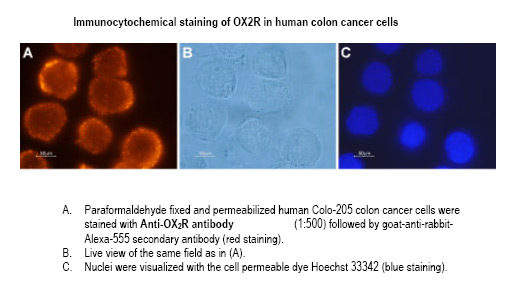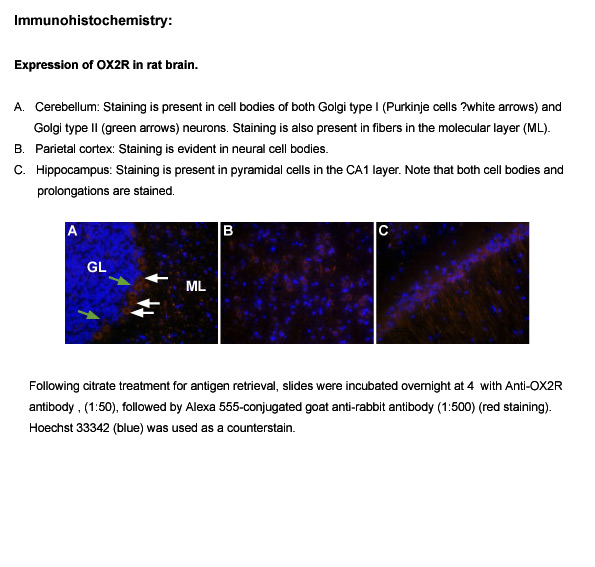Anti-Orexin Receptor 2 Antibody
| Cat. No. | Y051682 |
| Name | Anti-Orexin Receptor 2 Antibody |
| Clone | Polyclonal |
| Category | Polyclonal Antibodies |
| Gene Name | Orexin Receptor 2 |
| Application | WB,IHC,ICC/IF |
| Application Info | For research purposes only, not for human use. |
| Raised In | Rabbit |
| Clonality | Polyclonal |
| Reactivity | Human,Mouse,Rat |
| Description | Orexin Receptor 2 (OX2R) (also known as hypocretin receptor 2) is one of two receptors that recognize the peptide neurotransmitters orexin A and orexin B.1 Orexin A and B are 33 and 28 amino acids in length, respectively, and are derived from a common precursor termed prepro-orexin. OX2R binds both orexin A and B with similar affinities while OX1R binds orexin A with greater affinity than orexin B (a one order of magnitude difference).2,3 Both OX2R and OX1R belong to the 7-transmembrane domain, G protein-coupled receptor (GPCR) superfamily. OX2R is thought to transmit signals through the Ga11 class of G proteins, resulting in the activation of phospholipase C with subsequent triggering of the phosphatidylinositol cascade and an influx of extracellular Ca2 , probably through transient receptor potential (TRP) channels. OX2R can also transmit signals through inhibitory Gi G proteins, although the mechanism is less well understood.2,3 The physiological functions of the orexin system (OX1R, OX2R, and their ligands) have been a matter of intense research over the last few years. OX2R is expressed in both the central nervous system and peripheral locations such as gastrointestinal tissues, pancreas, and testis.2 The best studied physiological role of OX2R is its involvement in the regulation of sleep and wakefulness states. Studies in mice lacking the orexin gene and dogs expressing a null mutation of the OX2R show a remarkably similar phenotype to human narcolepsy, a condition characterized by excessive daytime sleepiness, inability to maintain vigilant states, and defects in the regulation of rapid eye movement (REM) sleep.4 In addition, the orexin system is involved in regulating autonomic functions such as blood pressure and heart rate, as well as in mechanisms that regulate the reward response in the brain.4 We are pleased to offer a highly specific antibody directed against an epitope located in the intracellular C-terminal domain of rat Orexin Receptor 2. Anti-OX2R antibody can be used in Western blot, immunocytochemical, and immunohistochemical applications and recognizes OX2R from rat, mouse, and human samples. |
| Immunogen | Peptide (C)DRLARGRTSTESRKS corresponding to amino acid residues 391-405 of rat OX2R (Accession P56719). |
| Isotype | IgG |
| Concentration | 1ug/ul |
| Recommended Dilutions | For research purposes only, not for human use. |
| Storage Buffer | PBS, pH 7.4 with 0.05% sodium azide. |
| Storage Condition | This product is stable for several weeks at 4° C as an undiluted liquid. Dilute only prior to immediate use. For extended storage, aliquot contents and freeze at -20° C or below. Avoid cycles of freezing and thawing. Expiration date is one (1) year from date of receipt. |
| Formulation | Liquid |
| Species Reactivity | Human,Rat,Mouse |
| Purity | Affinity purified on immobilized antigen. |
| Guarantee | abm guarantees that all our Anti-Orexin Receptor 2 Antibody will perform as described on this product webpage, if this is not the case we will provide you with a one-time replacement at no extra cost. Documentation and explanation of experiment conducted will be required when submitting a claim for replacement. |
| Material Citation | If use of this material results in a scientific publication, please cite the material in the following manner: Applied Biological Materials Inc, Cat. No. Y051682 |
Print & Download Datasheet
Search CoA here
There are no Documents for this product yet!
There are no FAQs for this product yet!
There are no references for this product yet!
This product has no review yet.
Browse Other Antibodies:
Select Rasied In:
Armenian hamster
(0)
Bovine
(0)
Chicken
(0)
Donkey
(0)
Goat
(0)
Golden Syrian Hamster
(0)
Guinea pig
(0)
Hamster
(0)
Horse
(0)
Human
(0)
Mouse
(0)
Other
(0)
Rabbit
(0)
Rat
(0)
Sheep
(0)
Select Reactivity:
Avian
(0)
Bombyx mori
(0)
Bovine
(0)
C. elegans
(0)
Chicken
(0)
CMV
(0)
Dog
(0)
Drosophila
(0)
E. coli
(0)
Fusarium sepsis
(0)
Hamster
(0)
HBV
(0)
Horse
(0)
Human
(0)
Llama
(0)
Locusta migratoria
(0)
Manduca
(0)
Mosquito
(0)
Mouse
(0)
Notapplicable
(0)
Other
(0)
Pig
(0)
Planaria
(0)
Porcine
(0)
Quail
(0)
Rat
(0)
Rodent
(0)
Sheep
(0)
Species independent
(0)
Spodoptera frugiperda
(0)
Xenopus
(0)
Zebrafish
(0)




